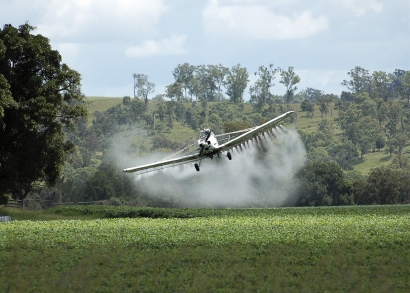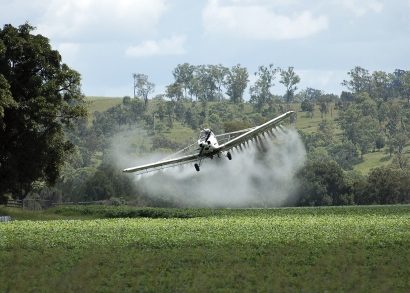 The never-ending war on weeds.
The never-ending war on weeds.
UPDATE at bottom of post.
————————————–
I’m an ag nerd, so sometimes you’ll catch me reading stuff like Delta Farm Press–a trade publication for large-scale farmers in the deep south.
I find the damnedest things on those reading jags. Here’s one: farmers down there–which is cotton, soy, and corn country–are having a hell of a time controlling weeds, and resorting to evermore complex herbicide cocktails to combat them.
The dominant herbicide is still glyphosate, a broad-spectrum herbicide marketed by Monsanto as Roundup. Monsanto, of course, has established itself as an agribusiness giant by selling “Roundup Ready” corn, soy, and cotton seeds–genetically engineered to withstand copious lashings of Roundup. (Scientists recently discovered that the “inert” ingredients in Roundup damage human cells. Oh-oh!) The technology makes farming easy. You plant your seeds, and anytime weeds break out, you can knock them down with herbicide, without damaging the crop a bit! Except … Roundup applications have become so heavy that weeds are starting to develop resistance.
And that is causing farmers to think hard about the pesticide-treadmill problem–the situation wherein weeds and other pests develop resistance to poisons, demanding ever higher doses of old poisons and constant development of novel ones.
I actually made that up. The glyphosate-resistance problem is just causing the treadmill to speed up. In a recent Delta Farm Press piece, Ford L. Baldwin of Arkansas-based Practical Weed Consultants (note the crop-duster Web-page art) writes:
I am continuing to get reports on suspected herbicide resistance situations. My University of Arkansas counterparts are getting a lot more than I am. This may well be the breakout year on Palmer pigweed resistance we have been expecting.
He moves quickly to what he sees as the solution to the problem: collusion among the four companies–Monsanto, Syngenta, Dupon, and Bayer–that own the market for GM seeds. He writes: “A lot of companies are working on trait packages and a lot of companies that have been competitors will be combing technologies and becoming best friends to try and stay in business. All of this takes time.”
His dream: that Bayer’s “Liberty Link” trait–which allows engineered plants to withstand the herbicide glufosinate –will be “stacked” with the Roundup Ready trait. He writes:
I have a lot growers telling me on LibertyLink soybeans, “I think it is good technology, but I want to wait until it is stacked with Roundup Ready.” A LibertyLink plus Roundup Ready stack will be a fantastic product. I am excited about the possibility, but when will it be here? Agreements, approvals and variety development all take time. In addition sometimes things jump the tracks.
Wow. So you’d get farmers dousing their fields with not one but two broad-spectrum herbicides–blotting out biodiversity while conjuring up a few super-duper-weeds that will need their own chemical/GMO “solution” in the near future. [See update below.]
Lurking on the message board of another aggie Website, Farm Journal’s AgWeb, I found three provocative tidbits on this topic. Now, it’s impossible to judge the reliability of posts from anonymous message boards; I will be following up on these leads in the days ahead.
1) At least some farmers evidently aren’t thrilled with the prospect of a Liberty Link/Roundup Ready mash-up. “Those of you who wish to have RR and LL in the same seed have done flipped your wigs!” declared one. Others seemed to agree.
2) Roundup Ready corn may already be tolerant to Liberty Link, even though Roundup Ready seed bags don’t include that trait. Several farmers in the discussion thread claim to have inadvertently sprayed Liberty on fields planted with Roundup Ready seeds–and the plants didn’t die.
3) The farmers in the discussion thread casually mention “RR yield drag”–the idea that Roundup Ready soybean seeds deliver lower yields than conventional. Of course, according Monsanto’s marketing blitz, its products are all about boosting yield.
The exchange suggests just how hard conventional farmers fight to chemically control weeds. I found further illustration of that in yet another Delta Farm Press article.
Entitled “Hard-to-control weeds common,” the piece gives an idea of the dizzying array of herbicides being used. Here’s a typical passage:
[LSU weed specialist Bill] Williams said Louisiana growers usually do a “great job of tank-mixing, using things like metolachlor/Flexstar and things like that. The problem with metolachlor and Sequence is they’re strictly a soil-applied herbicide. If you spray on growing weeds, it won’t help you any. And you’ll have lost the benefit of using a residual.”
Weed researchers have done many demonstrations with both teaweed and pigweed, primarily in soybeans. “We’ve had a lot of luck – growers have been very happy – when using something like Valor or Goal in a burndown program. That provides a two- or three-week window when the cotton or beans are coming up. Growers are able to delay an application a bit longer and it keeps the bigger pigweeds in check – they don’t come up at the same time the cotton or soybeans are emerging.”
Wow. Metolachlor/Flexstar, Sequence, Valor, Goal–herbicide names just slide off the tongues of these “weed specialists.” Plus you get lingo like “burndown program.” Are these people farming or fighting insurgents? The question isn’t entirely rhetorical. During the Vietnam War, an herbicide called Agent Orange, marketed by Monsanto, got plenty of use as a “defoliant.”
The article also reveals that ryegrass appears to have gained Roundup-resistant “superweed” status. “I hesitate to go out and screen all these populations just to confirm resistance [to glyphosate],” declares a harried weed specialist. “It’s already obvious we can’t control it anymore–call it what you want, we can’t kill it.”
The problem is evidently quite troublesome, prompting a veritable cascade of herbicide names from the weed specialist.
And there are not a lot of good programs to turn to. Resistance has already been confirmed with a lot of the ALS herbicides and some of the graminicides like Hoelon and Select.
What will control the ryegrass? “Really, we just need to try some things and see if it works. If you don’t have ALS-resistant ryegrass in corn, it can be taken out with Accent and Steadfast. Beacon works a bit.”
The biggest limitation is many growers have gone back to the Counter programs. “If you’re using Counter, then Accent, Steadfast, and Resolve are all out and can’t be used post-emergence in corn. If you have a ryegrass problem and are planning on using Accent, make sure you have an appropriate insecticide program. [Emphasis added.]
Right–can’t forget that other class of agricultural poisons, the insecticide.
Now, weeds are vexing problem, and organic farmers struggle with them, too. But their methods–handwork, intensively planting highly fertile beds, mulch, mechanical cultivation–don’t generate weed resistance. Rather than increasing long-term weed pressure, these methods can actually decrease it by working down the “bank” of weed seeds on a piece of land.
These methods are not easy, they’re management intensive, and require lots of thought and work. But then again, from reading the big-farm press, the same applies chemical farming!
For your reading pleasure, here’s another chunk of that last article, with herbicide names being dropped like those of starlets in a gossip column. Emphasis mine:
Williams’ preferred approach: try to spot-spray areas where glyphosate failed in the normal burndown program.
“We’ve had very good luck with Gramoxone as long as the ryegrass is headed out. By using something like Gramoxone/diuron, it can be picked up. But it must be headed out. If it’s in the boot stage, or prior to it, it’ll just regrow. It has to be put out before flowering, so there’s about a two-week window in which to make the application.”
It’s all about timing, whether dealing with burndown or early-season weed control. “An Extension associate did a survey early in the spring in northeast Louisiana cotton and soybeans. Roughly, he found 70 percent of the soybean and cotton fields were unidentifiable. Those fields were cleaned up but, at some point, that will lead to resistance issues. It’s the same thing as cutting the glyphosate rate by half. Don’t let weeds get up to 10 to 12 inches tall.
“If you use something like Sequence to help with resistance, get the benefit of the residual. Make the application early when weeds are small. That’s why Dual is in there.”
Williams has checked several experimental compounds for weed control in corn. “Of course, we want to avoid resistance issues, so there’s a need to get away from only glyphosate-based programs.
Halex GT, a glyphosate-based program, has been “a very good product. Steadfast from DuPont does a good job. Laudis has done pretty well for us although it doesn’t have quite as much residual as Halex with Dual.
“We also looked at Corvis and Caprino. I’m not sure if they’ll be available next year. But they were very good standalone programs.”
So much corn, cotton and soybeans coming off before mid-September means “there’s a lot of time for weeds to grow. If you’re renting land, it’s difficult to go clean up fields. But your own land is worth cleaning the fields up in the fall. That not only will help with the next year’s weed control but it’ll help with insect populations by removing overwintering sites.
“A simple layby diuron/Linuron combination (half pound of diuron/half pound of Linuron) has been our best, overall. The problem with Envoke, Staple and products like that is when you’re dealing with (larger) teaweeds, they won’t do the job. Roundup won’t kill them either.”
Next to resistance issues and ryegrass, the next most important thing Williams has faced this year is volunteer crops. In mid-June, “we’re still getting calls on controlling volunteer corn, particularly in cotton. I believe Staple or Envoke is the way to deal with that. Select does a good job but if you’re dealing with other weeds, you might as well get more out of the application.”
In a layby situation, what is available that’ll hold grass for longer other than Dual or Sequence? “We’ve spent a lot of time looking at that. Dual will provide three or four weeks of control. In irrigated crops, it won’t last much longer. In dryland, it’ll last a couple of weeks if there’s a rain.”
Researchers have also checked diuron, excessive rates of atrazine and Dual. But there’s nothing available “that will hold from now until mid-August. Once the corn starts drying down or the cotton is defoliated, the first rain will push weeds out.
“In some ways, I kind of hope there won’t be a herbicide like that. If one comes out, you’ll be tied to a specific crop for the next year. That strong a residual will limit crop rotations, tie your hands.
“The closest thing we’re looking at that could help is some GAT corn and GAT beans. That may help out because there are some herbicides with very long residual control.
“The best weed control you can get right now is a crop canopy.”
———————————
UPDATE: EPA approves “stacked” Roundup Ready and Liberty Link Seeds and slashes “refuge” requirements
Via Twitter, a Monsanto representative informed me that just today, the company received regulatory approval for its “SmartStax” initiative, which, among other thing, will include seeds with both the Roundup Ready and Liberty Link traits. “[And] it’s labeled,” the rep added helpfully. Well isn’t that special! Monsanto’s press release on the topic brims with interesting info. In addition to the Bayer mashup, Monsanto is also combining insecticide corn traits with Dow AgroSciences. They’re claiming that the release will mark “the largest introduction of a corn biotech seed product in the history of agriculture.” Interestingly, the press release adds that in approving the new combinations, the EPA is also slashing the amount of “refuge” land farmers are required to keep–land planted in non-GMO varieties. The EPA requires refuge land to try to slow the very kind of resistance issues discussed above. “The decisions by the EPA and [Canadian Food Inspection Agency] will allow reduction of the typical structured farm refuge from 20 percent to 5 percent for SmartStax in the U.S. Corn Belt and Canada and from 50 percent to 20 percent of the U.S. Cotton Belt,” the press release states. I’ll be phoning up EPA press officers for more information on these questions tomorrow.



